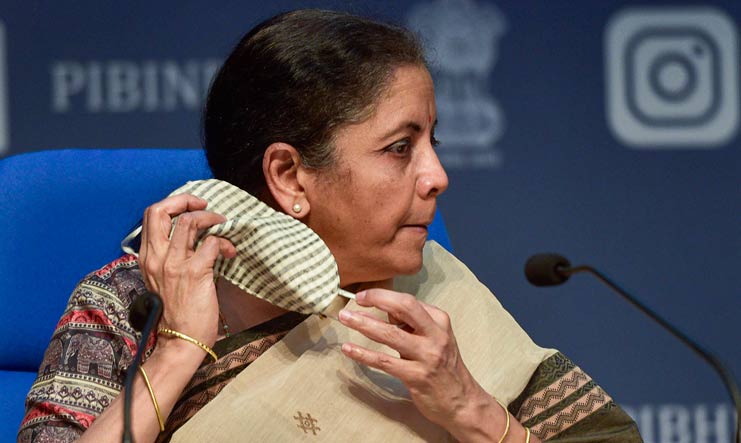Many a slip between the cup and the lip? In India, make that to many a slip between lip service and the cup not getting its fill.
The call has been made—Atma Nirbhar, and ‘vocal for local’ it is going to be. The announcements have been done—no direct cash transfer like many hoped, but oodles of money to be disbursed as loans across schemes galore. Indian government has put up grandiose ‘stimulus package’ as its main battle plank to take on the post-COVID economic woes. Over to you, lenders.
With lakhs of crores offered by the government on tap for small and medium businesses (MSMEs), as well as farmers and for other schemes, the banker is at the centrestage of the stimulus package. Sitharaman’s multiple tranches included Rs 3 lakh crore government-guaranteed loan for MSMEs, Rs 45,000 crore liquidity infusion for financial institutions and another set of loans for farmers and allied agro businesses to be disbursed through NABARD.
The question is, will India’s banking system step up?
It is crucial since unlike developed economies, which have put money in the pockets of their citizens or covered professional salaries, India has not gone in for any sort of direct cash transfers (the PF cover for three months will cover just about 10 per cent of the work force). Instead, it has gone in for a scheme whereby lots of money can be taken on easy loans by entrepreneurs, which in turn can catalyse manufacturing, flow of wealth down the value chain and spur up consumption.
Or so it hopes. Speed will be crucial here, and that is exactly the worry. As S. Ravi, tax specialist and former chairman of the Bombay Stock Exchange, says, “The announcements can be anything, but I am more concerned about the effective implementation of all these decisions, the guidelines and how fast they roll it out.”
It is a loan mela of the sort we haven’t seen since the days before liberalisation. Sanjay Sharma, managing director and founder of Aye Finance, an NBFC focussing on small and micro enterprises, explains, “Unfortunately there is a huge reticence to lending amongst the financial institutions.” Over the past few years, banks have been questioned over the precarious state of their non-performing assets. Stories of high-profile businessmen, some of them said to be cronies of those politically connected, taking off the country after defaulting on huge loans had led to a string of investigations, and even new regulations. Revelations of deep malaise in places like Yes Bank and the Punjab and Maharashtra Co-operative Bank (PMC) only put bankers in the dock, with every commercial decision and granting of big ticket loans questioned. “That was unfortunate,” points out Sharma, adding, “Some of it happened just before COVID-19 broke out. That is weighing on the minds of these institutions.”
If that was not enough, the very nature of banking could turn out to be an impediment. “Bankers tend to be conservative,” explains Sharma. “They do not find it comfortable to see easy flow of money. (But) The need of the hour is just that.” Estimates are that anywhere up to 12 per cent of loans taken by MSMEs, from a total of nearly 18 lakh crore rupees, are NPAs. Bankers are only justified to fear this figure will go up once you add the loans just announced. The rating agency Crisil has already said NPAs are likely to burgeon due to COVID-19.
“Lenders ask hundreds of questions before lending money,” Sharma points out, adding, “They will (go about loan disbursal) slow. But (the problem here is) that if it does not happen quickly, it will go to waste.”
Perhaps it is because she realized this that the finance minister said she will personally monitor the progress of loans on a weekly basis. “It will require the constant goading of (lenders by the) government,” Sharma assumes.
But who do you lend to? “It depends on the guidelines, how RBI communicates with the institutions,” argues Ravi, “Do the banks give the loans to registered MSMEs or to existing clients? Or do they go by some list from the MSME ministry? And what about MSMEs who have defaulted on loans due to lockdown or due to other reasons? How do you decide?”
There is also a fear that the present availability of easy funds, with the government guaranteeing them, could be misused. “Banks will now lend more money to (existing clients) and ask them to return older outstanding loans and default on the fresh loans given to them. Banks reduce their NPAs and they lose nothing if the new loans are not repaid. So, it is credit flow without collaterals which is the easiest way for businesses to make a quick buck,” Aunindyo Chakravarty, an economic analyst wrote recently.
Sharma feels India’s MSMEs can be trusted to step up. “India’s MSMEs are frugal, use lesser working capital than big businesses and have been highly under financed. Especially micro enterprises’ ability to withstand challenges and disruptions is surprisingly high. A lot of comments are also coming to the table that may be it would be the MSMEs who will do well and draw the country out of the present challenges!” Provided, the banks and financial institutions lose their inhibitions and conservatism and start playing ball, of course.



